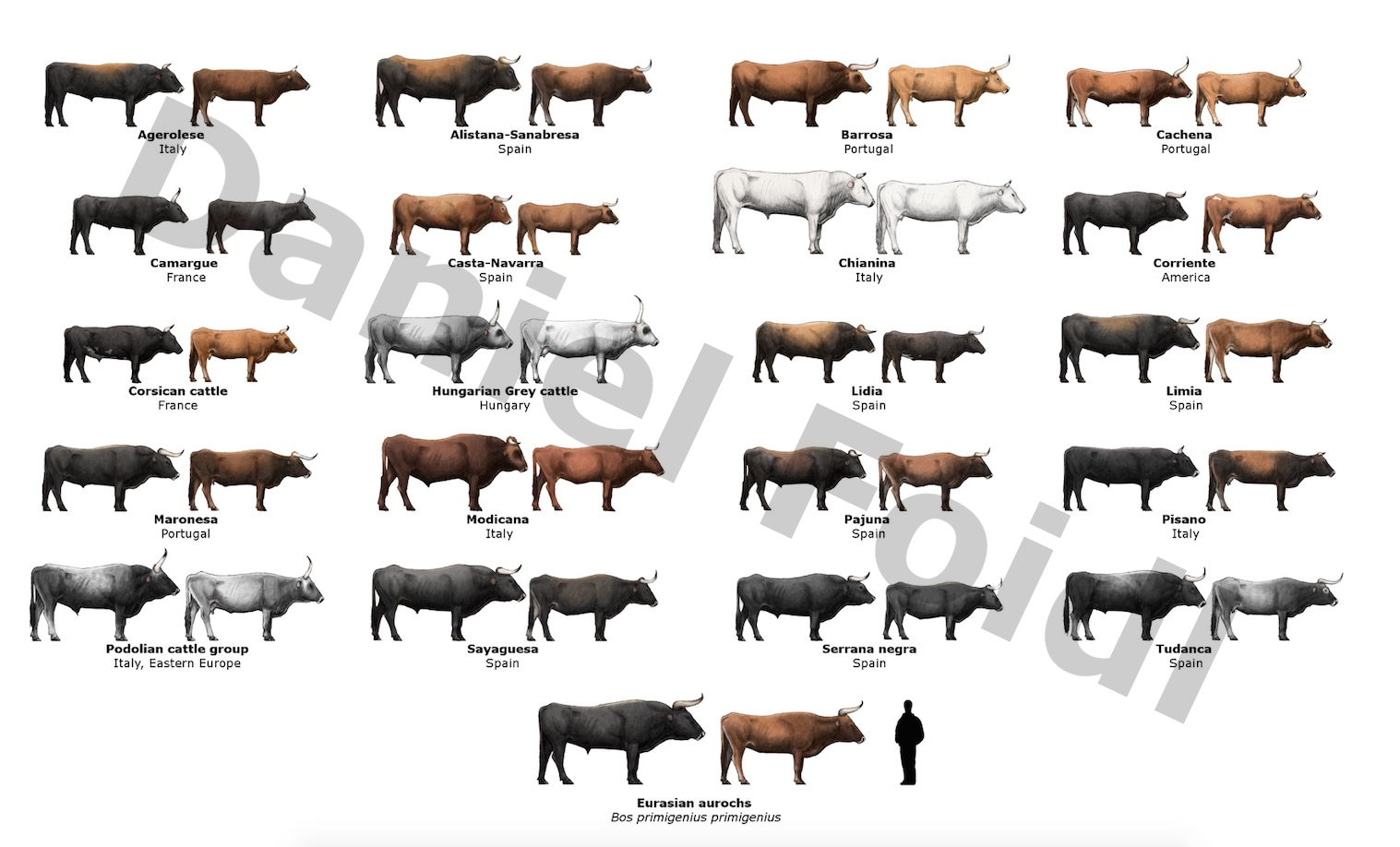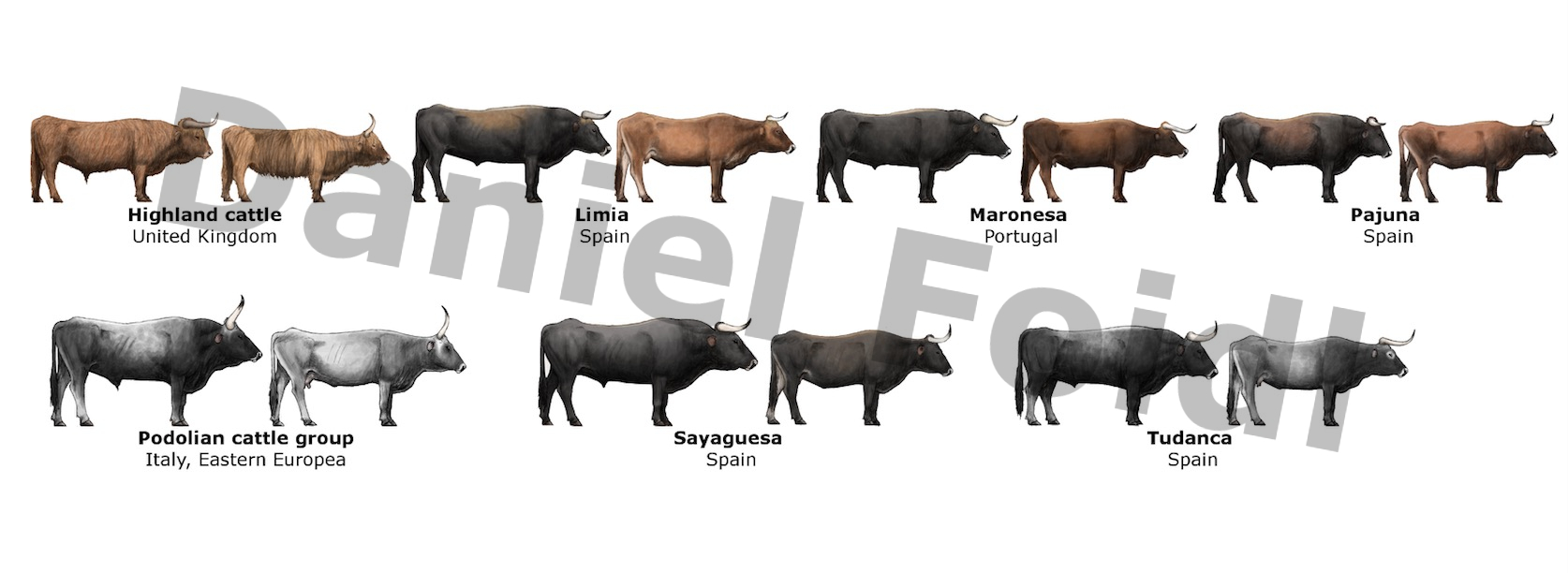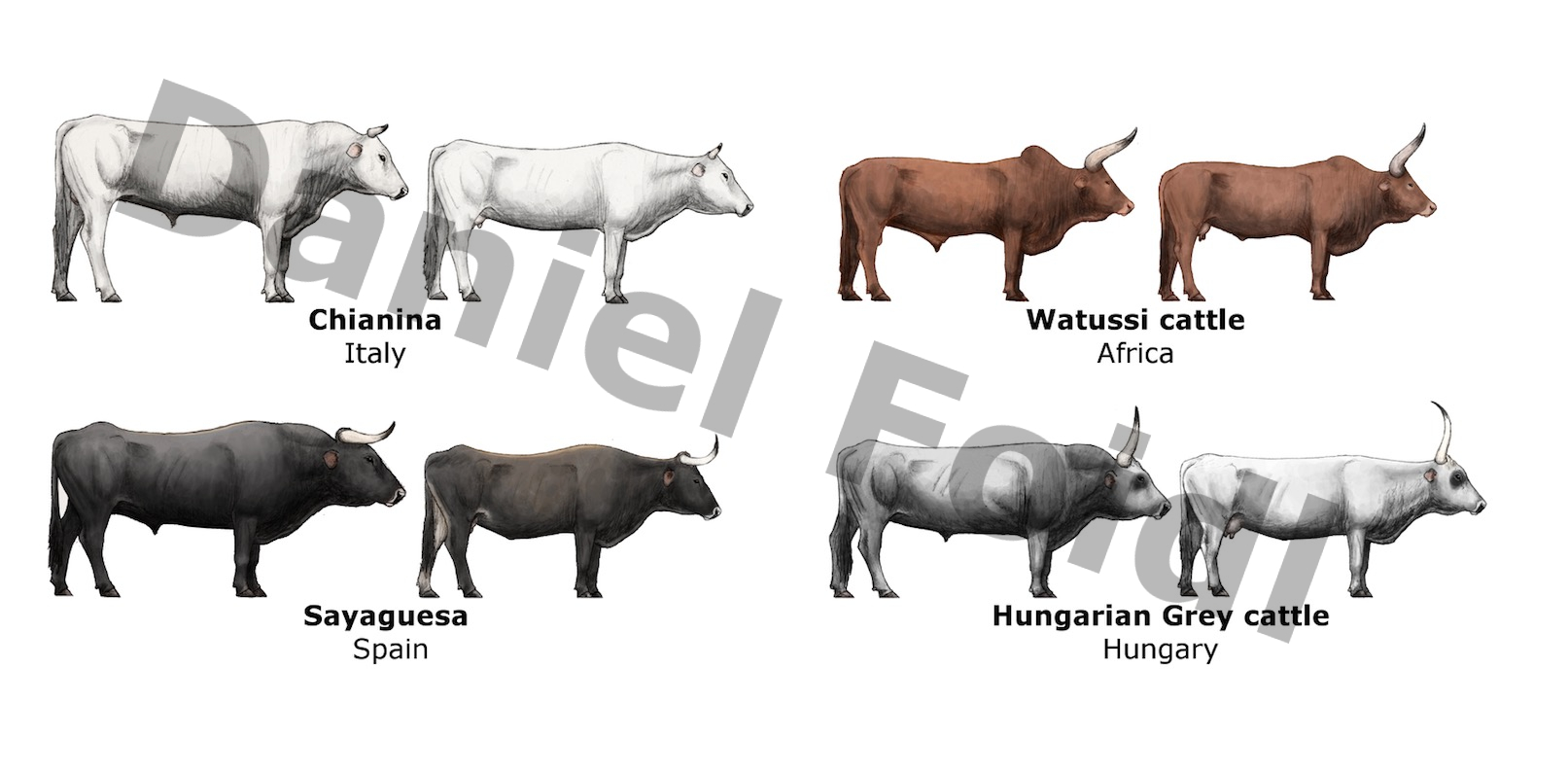What I am
going to present to you now is the work of several weeks. I am sure that a lot
of my readers will know my table of a selection of aurochs-like cattle I did
for Wikipedia, showing breeds used in the Tauros Project in comparison to the
aurochs. However, looking at it now it is unsatisfying. Some of the drawings
are anatomically imprecise and sloppy, and not always artistically convincing.
Furthermore, out of laziness, some of breeds are just modified versions of the
aurochs drawing at the bottom. Also, many of the drawings are “too optimistic”
over proportions, body conformation or size of the respective breeds. And there
is another problem since the table was originally meant to be an illustration
of the Tauros breeds: Highland cattle and Tudanca are missing. So I felt I had
to do a new one.
But I wanted
to draw way more breeds than just the cattle used in Tauros, therefore I
decided to split the images up: one table showing a selection of aurochs-like
breeds in general, and one showing the breeds of Tauros. Then I had the idea to
do one for the Uruz Project as well. And also my aurochs vs. Heck cattle
drawing desperately needed a remake. All in all I decided to do 23 breeds plus
the aurochs as a reference – both male and female, therefore 48 individuals.
I believe
that one cannot make a useful distinction between “aurochs-like” and “non
aurochs-like” cattle because there is a fluid continuum, therefore the level of
primitiveness I chose is arbitrary. As on the original version, optics are the
main criterion, otherwise I had to include feral but not that aurochs-like
cattle as well. I chose to do the primitive landraces, so Heck cattle is not
included, because it is a result of the first “breeding-back” attempt and
therefore another story. But I did this breed as well, on the “Heck vs.
aurochs” table. (I could have illustrated Taurus cattle as well, but for now
this “breed” is a bunch of recent crossbreeds, many of them still half-pure,
and there is a continuum to non-crossed Heck cattle, what is why I regard it as
a special, advanced form of Heck cattle) This highly heterogeneous breed was a
bit of a challenge, because my intention was to present average, representative
individuals and there are just so many possibilities.
Actually I
faced that problem in a lot of breeds. I did not want to do the “best of the
best” individuals, but animals that give a balanced impression for the whole
breed. However, I excluded the really ugly and derived or obviously crossed
individuals from my consideration. My Limia bull has a light colour saddle,
although there are Limia bulls that do not – I gave my bull a saddle not to
implicate that the colour of this breed is always the same as in the aurochs. The
same goes for my Lidia and Heck, although there are members of the breed with a
fairly accurate aurochs colour. The same goes for horn shapes. I had to pick
those traits that are prevalent, and if these are very aurochs-like but not
always, I included some minor “flaws” in my drawing. Otherwise the image would
be blurred.
All animals
are drawn to same scale. My aurochs bull is meant to be 180cm at the shoulders,
because I intended to take the Eurasian, specifically Central European, aurochs
as a reference, which is usually the target of “breeding-back” projects. For
some breeds, deciding for the right size was tricky, especially those which
bear a lot of variation. I mainly took the Domestic Animal Diversity
Information System as a reference, but also other sources and what I some
breeders told me. For some breeds I was not able to find precise information,
so I had to guess.
My drawings
are pencil drawings that were painted with GIMP. Each individual was painted
separately, but I did not do a pencil drawing for all of them: I edited the
pencil drawing of the Pajuna bull and cow into Modicana, the Casta-Navarra bull
is the Lidia bull with head of my Alistana-Sanabresa, both Serrena are a plumper
version of the Sayaguesa, and the Tudanca cow is the Limia cow with a fitting
horn shape.
Only the
great table shows a human (man, about 180cm tall) for comparison, I decided not
to insert a human or scale bar into the other images to not distort it.
Table of
the 20 breeds:
Breeds of
the Tauros Project:
These are
the main breeds of the Tauros Project. You might point out that one of their
Sayaguesa cows is 25% Alistana-Sanabresa, but I do not consider that relevant –
otherwise I would mention that breed as a founding breed for Taurus cattle as
well. The “Podolian cattle” are representative of Podolica, Maremmana and
Boskarin, and whatever they are going to work with from that group. From what I
have heard they are also going to use local breeds in Eastern Europe, but so
far there is nothing official that I know of.
Breeds of
the Uruz Project:
Well there
is not much to say. The Uruz Project also intends to do breeding projects with
Maronesa, Barrosa and Lidia, but only by selection within the breed alone. My
table shows the breeds that are used for crossbreeding for now.
Heck cattle
compared to the aurochs:
I chose normal
Heck cattle size of about 142 cm (bull) and 132 cm (cow) at the shoulders.
There were about a dozen possible colours for both sexes in sum, and the level
of sexual dichromatism ranges from as strong as in the aurochs to nil. My Heck
bull has a light colour saddle, to show that a considerable number of Heck
bulls has it (probably about the half or so) and that the sexual dichromatism
weaker than in the aurochs after all. This colour saddle could have had a
reddish tone, but I decided to give it a light beige tone to show that Heck
cattle often have a more or less diluted colour without exaggerating it. The
cow however is undiluted. It is a little bit darker than what we imagine most
aurochs cows to be. All in all I think that both individuals display colour
schemes that are very widespread in Heck cattle, and that I was neither too
pessimistic nor too optimistic regarding sexual dimorphism. Some Heck cattle
have small white spots on their belly or in rare cases are completely piebald,
so I was not sure whether one of my Heck individuals should show a little spot
or not. I came to the conclusion that, although it is very apparent in a number
of individuals, they are not common enough in the population to be necessarily
included into my illustration.
There are
also a lot of possibilities of what the horns of a Heck bull or cow looks like.
Either the horn shape is more or less reminiscent to that of the aurochs or not
at all – either their size is as large as in the aurochs or even really large,
or rather small. Often the horns are as upright as in Podolian cattle, sometimes
about 90° relative to the skull and very rarely below. I chose to give my Heck
cattle “usual” horns that are common in the breed: medium-sized horns, with a
curvature that is basically reminiscent to that of the aurochs but too weakly
pronounced, to much upwards and outwards, which the bull having horns facing
slightly more forwards than in the cow. Regarding body shape, proportions,
dewlap, udder and skull shape, I tried to avoid the extremes and to show what
is most common in the breed.
Honestly I
have to admit that I think I did a good job at illustrating “typical” Heck
cattle and that my comparison with its ancient predecessor is fair.
Overall I
am very contended with my new illustrations, both regarding authenticity and
also artistic quality. It was a lot of work, but also a lot of fun. I hope you
like them too!
(Sorry
about the watermarks. They are just the consequences of experiences I had to
make)





Hey,
ReplyDeletecongratulation, you did a really great job on your illustrations (and of course the whole blog!)!
I have to say, that I didn't really like the body shape of the old illustrations, particularly the heads, so I'm glad you improved that.Not that those illustrations were bad but I just didn't like that fact.
Don't worry about the water marks, you have every right to put them on your own work!
Thanks for the blog and all the work you`re putting into it.
Best regards
Ursus Major
Thanks! Yes, the old ones were sloppy. Actually I intended to draw the new ones in order to replace them on wikipedia, but they turned out to be too qualitative for my taste to upload them to wikimedia and give everyone the right to use them how they want. At the moment I am too "exhausted" to do new ones for Wikipedia.
DeleteThis is absolutely amazing but if I may make a suggestion for one alteration. At the bottom it would be awesome to see, the other side of the human scale figure, an example of a typical domestic cow which is as non-aurochsy as possible (a fresian for example). This would really emphasise the differences and make people who are used only to seeing "typical black and white cows" appreciate the differences in structure more (just my opinion).
ReplyDeleteThis is truly awesome work - great job.
Actually the table with the 20 breeds has a human next to the aurochs. For the other ones, I considered to add one to but I thought they would distort the image. However I could change that, but for now I don't feel the need to.
DeleteI also considered to add one of the very derived breeds, f.e. Fleckvieh, but then I thought it is not really necessary as everyone knows those cattle and drawing 48 individuals was already much enough....
Hi, I'm from Spain and I follow your blog, I think it is the most complete and informative tool about the Aurochs reconstruction and I really appreciate your drawings. I neither have much hopes on the Taur0s project, too much breeds used there and Highland cattle was IMO a mistake, though I hope Uruz Project to be better.
ReplyDeleteThanks for the kind words!
DeleteRegarding the Tauros Project, only time will tell, but my honest prognosis is that their cattle will be probably as good as Taurus cattle, and they also have large quantities by now already.
Yes, it will end up looking good but given the big number of breeds used it will take so many years. Have you ever heard about the bulls called "media casta"? They are bulls of dark, primitive and big races (like Sayaguesa and similar) mixed with Lidia so they have Lidia features like body structure but they have a much less aggresive behaviour, and were used for soft, less dangerous bullfighting.
DeleteI just googled for that breed/strain but I didn't find that much...
DeleteIt is not a breed or a strain but a generical name for Lidia + non bullfighting bulls from NW Spain (generally Sayaguesa). I'm pretty sure this is one of them:
Deletehttps://www.youtube.com/watch?v=vqHQ1KsSsmU
Take a look at this video.
ReplyDeletehttps://www.youtube.com/watch?v=JMWrXkLGCwA
Wow, huge one. Thanks for the video, I think I have seen some photos of that individual previously. Holstein are a two-edged sword. On the one hand, their skulls, proportions and sometimes also ribcage morphology are very useful, just as their size. On the other hand, most of them have huge udders, their recessive white spots are a pain in the *** and their ecologic capacities are AFAIK untested.
DeleteCasta Navarra is in fact one of the "castas" (lineages) of Lidia, together with the Casta Cabrera (e.g. the famous Miura bulls), Casta Vazqueña and the best known of all, Casta Vistahermosa.
ReplyDeleteHi, is there any chance I could buy https://farm1.staticflickr.com/401/18391701903_49c6c19e4d_o.jpg this picture in high resolution and without the watermarks from you? I want to make a poster for my office.
ReplyDeleteThe patience and attention to detail it takes to complete such an artistic undertaking amazes me. The presence of mind necessary to maintain a mental map of breed traits as you work is a very male characteristic which I have seen before and admire greatly. To help with a remark from URO earlier, I heard that the Highland was chosen for its unique behavioural characteristic of hiding the calf in the same manner as deer, returning to suckle it after grazing with the herd. Relieved to see the Chianina being used in the Uruz project to get the height back in early on. Your blog is the first place I've seen mentioned the length of face yet to be achieved. I look forward to the progress of these projects over the next few years. Are there progress reports issued or stages of accomplishment recognised at one- or two-yearly intervals - would the best examples of the animals chosen to go forward to the next generation be worth illustrating ? There would thus be a developmental reference available when the breed finally emerges. That would be some project!
ReplyDelete